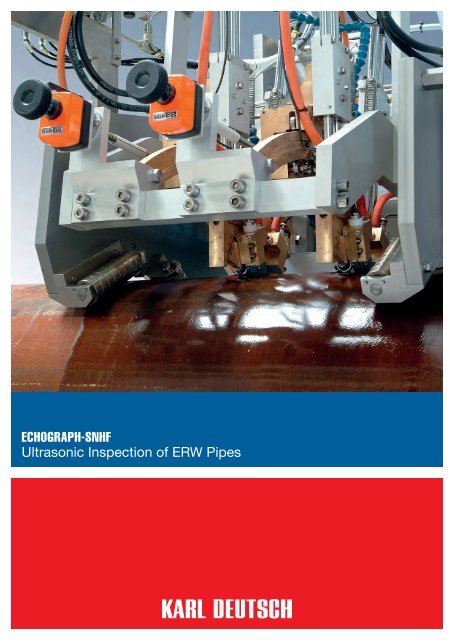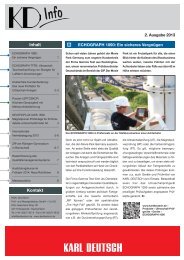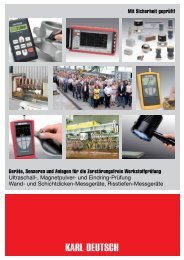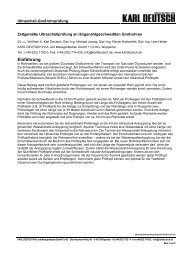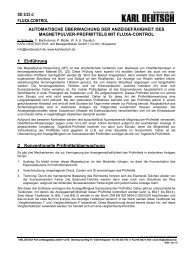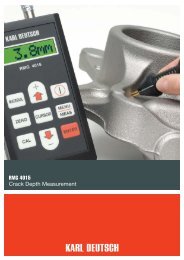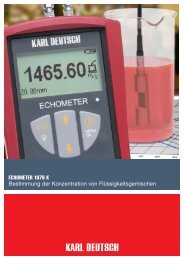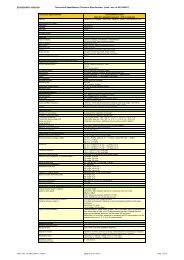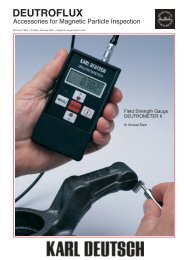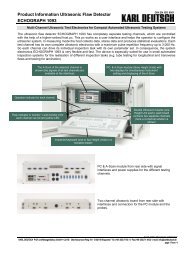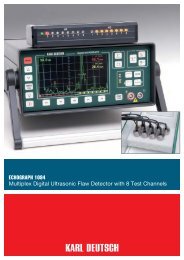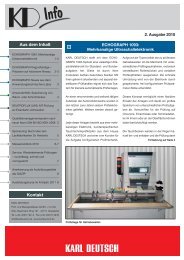ECHOGRAPH-SNHF Ultrasonic Inspection of ERW ... - Karl Deutsch
ECHOGRAPH-SNHF Ultrasonic Inspection of ERW ... - Karl Deutsch
ECHOGRAPH-SNHF Ultrasonic Inspection of ERW ... - Karl Deutsch
Create successful ePaper yourself
Turn your PDF publications into a flip-book with our unique Google optimized e-Paper software.
<strong>ECHOGRAPH</strong>-<strong>SNHF</strong><br />
<strong>Ultrasonic</strong> <strong>Inspection</strong> <strong>of</strong> <strong>ERW</strong> Pipes
<strong>ECHOGRAPH</strong>-<strong>SNHF</strong><br />
<strong>Ultrasonic</strong> <strong>Inspection</strong> <strong>of</strong> <strong>ERW</strong> Pipes<br />
Online Testing System for <strong>ERW</strong>-Pipes:<br />
The probe holders can be moved<br />
between the testing position and the<br />
calibration position. In the calibration<br />
position, a short pipe segment is used<br />
for the sensitivity setting <strong>of</strong> all probes.<br />
Probe holders for online testing machine (transverse and longitudinal<br />
defects)<br />
<strong>Ultrasonic</strong> <strong>Inspection</strong> <strong>of</strong> <strong>ERW</strong> Pipes<br />
The production <strong>of</strong> <strong>ERW</strong>-pipes includes<br />
several steps <strong>of</strong> NDT. The usage <strong>of</strong> NDT<br />
has two major goals:<br />
Early information about the welding procedure<br />
as a feedback for the production<br />
line and secondly, the final inspection <strong>of</strong><br />
the finished pipe. Up to four ultrasonic<br />
systems are <strong>of</strong>ten encountered during the<br />
production process.<br />
As a first step, a strip tester can be used.<br />
Linear or oscillating test traces <strong>of</strong> the<br />
probes are possible. Directly after welding,<br />
a first online weld test is carried out<br />
with ultrasound. It is common to check<br />
for longitudinal defects only. Sometimes,<br />
an oscillating deburring check is added to<br />
verify the proper descarfing <strong>of</strong> the internal<br />
pipe wall.<br />
After pipe cutting, a final weld inspection is<br />
carried out (<strong>of</strong>fline weld testing). A testing<br />
portal with moveable carriage is commonly<br />
used. The testing portal shows the advantage<br />
that the weld is inspected without<br />
pipe movement, thus avoiding vibrations<br />
which could degrade the test results. The<br />
pipe ends can be tested in the same testing<br />
system or in a separate setup.<br />
In this example ten probes are used for <strong>of</strong>fline weld testing. The<br />
six angle beam probes use water jet coupling (also called squirter<br />
technique). The incidence angle can be adjusted without steps for<br />
a perfect setting with respect to pipe diameter and wall thickness<br />
and without changing the probe.<br />
Typical testing tasks for the <strong>ERW</strong>-pipe inspection.<br />
a) Strip inspection with edge probes and oscillating strip middle probes<br />
b) online weld test with 4 probes for longitudinal defect detection and an oscillating deburring check<br />
c) <strong>of</strong>fline weld inspection with 4 probes for longitudinal defect detection, 2 on-bead probes for transverse defect detection and 2 probes<br />
for lamination testing in the heat-affected zone
<strong>ECHOGRAPH</strong>-<strong>SNHF</strong><br />
<strong>Ultrasonic</strong> <strong>Inspection</strong> <strong>of</strong> <strong>ERW</strong> Pipes<br />
Test portal (<strong>of</strong>fline test machine) during assembly at the KARL DEUTSCH workshop<br />
Test portal (<strong>of</strong>fline test machine): Onsite operation with transverse conveyor for pipe feeding and linear discharging <strong>of</strong> the pipes. This<br />
machine was also equipped with two additional probe holders for the pipe end inspection.
<strong>ECHOGRAPH</strong>-<strong>SNHF</strong><br />
<strong>Ultrasonic</strong> <strong>Inspection</strong> <strong>of</strong> <strong>ERW</strong> Pipes<br />
The inspection <strong>of</strong> the pipe body and/or the pipe end can be performed with separate testing systems or with additional probe holders in the<br />
<strong>of</strong>fline portal. Separate systems <strong>of</strong>fer a higher overall throughput (e.g. BAPS strip testing system, RPTR pipe testing portal, REPS pipe end testing<br />
system, see separate brochures). This example shows an <strong>SNHF</strong> weld test portal with two additional pipe end probe holders. The portal can<br />
be used bidirectionally. Depending on the test direction (left to right or right to left), the respective pipe end probe holder becomes active.<br />
Specimens<br />
<strong>ERW</strong>-pipes (single or endless pipes)<br />
Material <strong>ERW</strong>-welded steel pipes<br />
Diameter range (D) up to 630 mm (to be discussed)<br />
Wall thickness (s) 3 - 30 mm<br />
Length endless (online test) or 3 - 25 m (<strong>of</strong>fline test)<br />
Ovality ± 0.5% <strong>of</strong> D<br />
Straightness deviation max. 2 mm/m<br />
Surface condition as rolled, without loose scale<br />
Temperature max. 80 °C<br />
Detectable flaws longitudinal and transverse flaws, laminations in heat-affected zone; option: laminations in pipe end<br />
and pipe body<br />
KARL DEUTSCH Pruef- und Messgeraetebau GmbH + Co KG<br />
Otto-Hausmann-Ring 101 · 42115 Wuppertal · Germany<br />
Phone (+49 -202) 7192-0 · Fax (+49 -202) 7149 32<br />
info@karldeutsch.de · www.karldeutsch.de<br />
DIN EN ISO<br />
9001<br />
certified<br />
PI <strong>SNHF</strong> e 2012 03 • Subject to change without notice • Printed in Germany


